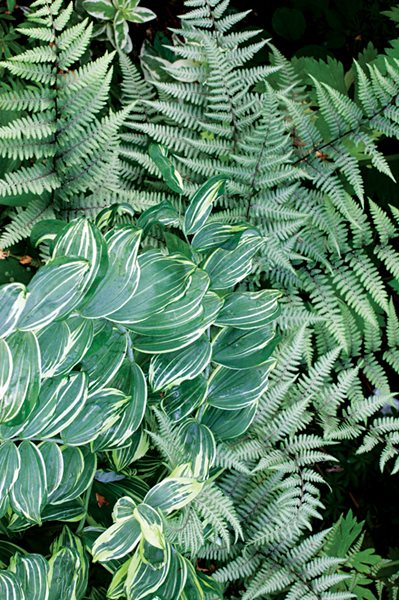Toronto Shade Garden
Garden writer Marjorie Harris shares with us her shade garden in Toronto, Canada, as well as a detailed list of plants that she uses in her garden.

We're so happy to be sharing some of photos of writer Marjorie Harris' shade garden, in Toronto. Harris is the author of Thirfty Gardening From the Ground Up (House of Anansi), which came out in March 2012. This story was featured in our March 2012 issue as "Shade Tolerant" and our online slide show has additional photos of this beautiful garden. Click through to read about how she transformed her garden, as well as a detailed list of the plants used in her garden.
Her garden has a layered, well-edited selection of plants appropriate for the Toronto climate and for her specific shade conditions. Bright chartreuse foliage of hosta and hakonechloa and variegated leaves of Cornus controversa ‘Variegata’ brighten the space and set off the darker burgundy foliage of the Japanese maple.

Back in 1967, we bought our house because it was in downtown Toronto, was big enough to accommodate four kids, and could be renovated extensively. But faced with a backyard 130 feet long and only 19 feet wide crammed full of weeds, who knew I’d rapidly become a full-blown plantaholic?
See a nearby garden:
My Garden: Lessons Learned

I began writing about gardens by default, urged on by my garden’s evolution and a growing obsession. No day went by without my taking notes; the yard became my library, my experimental lab until I found it difficult to write about plants I hadn’t grown. I figured out design against the odds — living next door to a massive, dangerously weak weeping willow, which cast all-embracing shade. Over the years, I also learned how to organize and perfect one small section at a time, to harmonize colors by picking up a tone from one plant and echoing it in the next pocket, working dramatically toward a focal point.
Shade, to me, is merciful, a blessed quality, not something to be rued. But my taste and the plants themselves change swiftly. One year I was on the prowl for the new or the unusual, others I concentrated on variegation or interesting foliage. When the weeping willow was removed, I got such a whack of sunlight I couldn’t stand it and set about planting more trees.

Shade plants have thrilling colors in their foliage. Though they produce rich blooms, that’s not the first thing to look for. It’s the leaves and textures that create the excitement. The list of shade plants is monumental, but I tell people to hunt for native woodlanders since many insects depend on them for survival. Start with a selection of ferns, hostas, and hellebores. All shade plants require the right soil (many only love acid) and excellent drainage with lots of humus in the topsoil.

We have now done our ultimate renovation: blasting out the back of the house to make a year-round garden dining room. I remade the garden into a tapestry wall with a concentration on the eye-level space, turning it into a highly complex view that changes with each season. It isn’t complete and perhaps never will be, but there is no time when it is not perfection to my own eye.

Consider the quality of your shade — wet, dry, deep, or filtered — and choose plants with strong foliage tones and dramatic contrasts in variegation. There is a huge variety, so design them to make a statement. All of these plants do exceptionally well in light to medium shade with well-drained soil and lots of organic matter applied to the surface.
Acer shirasawanum ‘Aureum’ with Berberis thunbergii ‘Aurea’ combines different tones of gold to help give each plant more depth, and they create a superb screen.

Athyrium ‘Ghost’ with Polygonatum odoratum ‘Variegatum’ (variegated Solomon’s seal, which doesn’t move around as rampantly as the species) is a very well-behaved, handsome pair.

Clematis ‘Betty Corning’ will bloom for weeks, has a lovely scent, and needs only to be pruned hard every spring. Let three stalks remain for a magnificent summer display.

Gingko biloba ‘Mariken’ is a dwarf (5 feet) standard form of an ancient tree and has a strong umbrellalike canopy.

Sambucus nigra ‘Black Lace’ (common elder) is in bloom, with black berries to come later. It can be pruned to any size or shape without mishap, though without a lot of whacking back, it can get huge.

Sciadopitys verticillata, or Japanese umbrella pine, is one of the finest evergreens to grow in light shade. The long needles have a velvet quality and hold up to harsh winters.

Cornus kousa var. chinensis ‘Samaritan’ is a variegated dogwood with silky ecru blooms in spring and a foliage color of creamy white and midgreen; it’s pretty much disease-resistant.

Hakonechloa macra ‘Aureola’ with Euphorbia amygdaloides ‘Purpurea’ and Hosta ‘Kabitan’ comprise a favorite section in the garden. It has the nicely tailored look in the microcosm in sharp contrast with the fluffiness of the macrocosm.

Gillenia trifoliata, Bowman’s root, is an eastern native with deep roots; cut it back after blooming for a second round of flowers.




